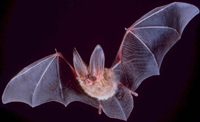Bats are masterfully adapted to life in the night skies. Now, two new studies demonstrate previously unknown abilities in bat species – an inbuilt magnetic compass, and a tongue so big it has to be stored in the rib cage.
If you were a biologist looking for astounding innovations in nature, you could do much worse than to study bats. Bats are like showcases of nature’s ingenuity, possessing a massive variety of incredible adaptations that allow them to exploit the skies of the night.
 They are the only mammal group capable of true flight and are one of only four groups of animals to have ever evolved the ability. As a result, they have spread across the globe with tremendous success. Today, one in every five species of mammal is a bat.
They are the only mammal group capable of true flight and are one of only four groups of animals to have ever evolved the ability. As a result, they have spread across the globe with tremendous success. Today, one in every five species of mammal is a bat.
They are most famous for their incredible echo-location. By listening for the echoes of sound waves rebounding off solid objects, bats have been finding their way in the dark using a radar that humans have only managed to duplicate millions of years later.
Magnetism
Echolocation is a short-range skill. Over longer distances, the bats’ ability to control their signals and perceive their echoes weakens, and other navigational skills must be used.
Until now, it was unclear what these might be. Richard Holland and colleagues from Princeton University have changed all that by showing that a large North American species, the big brown bat (Eptesicus fuscus), finds its way home by using the Earth’s magnetic field as a compass.
Holland took several big brown bats 20km away from their roosts and tracked their way home with radio telemetry. Before they were released, the bats were acclimatised at sunset to a magnetic field that was rotated to face either east or west.
For 5km, the group exposed to the easterly oriented field flew east, and those exposed to the westerly oriented field flew west. They were clearly using a magnetic compass which had been calibrated during sunset.
After initially losing their bearings, many of the confused bats corrected themselves and found the right way home. Holland believes that they recognised that the direction they were flying in did not match their magnetic map, possibly through other cues such as the position of the stars.
Other species including turtles and homing pigeons are known to navigate with a magnetic sense, but this is the first time the ability has been shown in bats. It adds to the already impressive array of senses that these animals possess.
A wicked tongue
Bats are also known for the variety of different food sources they exploit. Some species specialise in snatching spiders from their webs using their peerless radar, others take fish from lakes and perhaps the most famous representative drinks the blood of other mammals.
And many species make a living by drinking the nectar of the bountiful flowers found throughout the tropics, like leather-winged equivalents of hummingbirds.
Hummingbirds have evolved highly specialised relationships with flowers, so that some flowers are only accessible to a single species with the correctly shaped bill. Until recently, no such partnerships were seen between flowers and bats, mainly because the bat’s soft facial tissues are less easily moulded by natural selection than the bird’s hard bill.
The tube-lipped nectar bat (Anoura fistula) from the Andean forests of Ecuador is a striking exception (see left; photo by Nathan Muchhala).
 These cloud forests are home to a plant called Centropogon nigricans that has flowers 8-9cm long. No ordinary bat can feed from these.
These cloud forests are home to a plant called Centropogon nigricans that has flowers 8-9cm long. No ordinary bat can feed from these.
Nathan Muchhala from the University of Miami discovered that the tube-lipped nectar bat manages it with a tongue that is 50% longer than its body. In terms of relative size, its tongue is second only to the chameleon’s.
But where does a 5.5cm long bat store an 8.5cm long tongue? In most mammals, the base of the tongue is attached at the back of the mouth. But in the nectar bat, it is stored in its rib cage and its base lies between its heart and its sternum. Muchhala believes that the bat’s tongue and the Centropogon’s flower co-evolved to extreme lengths over time.
He captured various local bats over four months and found pollen from Centropogon nigricans only on the fur of the tube-lipped nectar bats and not related species.
Due to their exclusive relationship, the bat gets a permanently reserved dining spot and the flower gets a dedicated pollinating service.
Holland, Thorup, Vonhof, Cochran & Wikelski. 2006. Nature 444: 702.
Muchhala. 2006. Nature 444: 701.
Technorati Tags: bats, bat behaviour, magnetic sense, animal navigation, big brown bat, nectar bat, science
Filed under: Animal behaviour, Animal evolution, Animal kingdom, Animal movement, Bats, Evolution, Evolutionary arms race, Mammal evolution, Mammals |











Oh my gosh!!! I luuurve bats but I never knew that their tounges were sooooooo l-o-n-g!!!!!